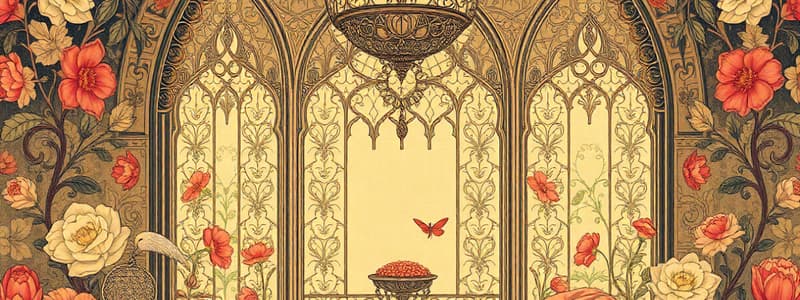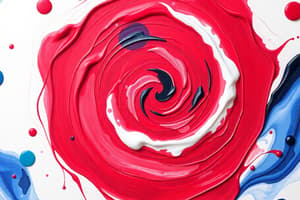Podcast
Questions and Answers
Match the following terms related to children's art education with their descriptions:
Match the following terms related to children's art education with their descriptions:
Replicas = Products that children are guided to produce instead of developing their own designs Teachers fixing = Intervention by instructors to ensure children's work meets specific standards Specific Instructions = Detailed guidance that leaves no room for individual interpretation Closed-ended activities = Art tasks that prioritize uniformity over personal expression
Match the following consequences of teacher intervention with their effects on children's creativity:
Match the following consequences of teacher intervention with their effects on children's creativity:
Intervening by trimming = Discourages experimentation in young artists Hovering over work = Creates an environment focused on achieving perfection Emphasis on product = Hinders artistic skill development Tightly controlled process = Limits opportunities for self-expression
Match the following phrases with their implications in art education:
Match the following phrases with their implications in art education:
Guided art production = Reduces individuality in children's creations Detailed step-by-step instructions = Restricts creativity and interpretation Teacher-led drawing = Limits children's exploration of artistic ideas Focus on uniformity = Prioritizes conformity over innovative expression
Match the following concepts with their potential benefits in art education:
Match the following concepts with their potential benefits in art education:
Match the following aspects of art education practices with their critiques:
Match the following aspects of art education practices with their critiques:
Match the following types of art with their characteristics:
Match the following types of art with their characteristics:
Match the type of art to its primary method of instruction:
Match the type of art to its primary method of instruction:
Match the type of art activity with its common example:
Match the type of art activity with its common example:
Match the type of art with its developmental benefits:
Match the type of art with its developmental benefits:
Match the activity to its categorization of art:
Match the activity to its categorization of art:
Match the aspect of art to its effect on children:
Match the aspect of art to its effect on children:
Match the exploration focus with the art type:
Match the exploration focus with the art type:
Match the educational outcome to the art type:
Match the educational outcome to the art type:
Match the description to the art approach:
Match the description to the art approach:
Match the examples with the correct art type:
Match the examples with the correct art type:
Match the art type to its characteristic focus:
Match the art type to its characteristic focus:
Match the instructional style to the corresponding art type:
Match the instructional style to the corresponding art type:
Match the key feature to its type of art:
Match the key feature to its type of art:
Match the activity types to their description:
Match the activity types to their description:
Match the art type to the primary learning focus:
Match the art type to the primary learning focus:
Match the developmental focus to the art approach:
Match the developmental focus to the art approach:
Flashcards are hidden until you start studying
Study Notes
Open-Ended Art (Process Art)
- Emphasizes exploration and experience over a final product.
- Encourages experimentation and discovery, fostering creativity.
- Child-led activities enable freedom in material choice and usage.
- Supports development of fine motor skills as children manipulate various materials.
- Enhances problem-solving abilities through realization of personal ideas.
- Aids cognitive growth by promoting innovative thinking.
- Offers emotional and social benefits, facilitating expression of feelings and collaboration.
- Example activities include finger painting, collage making, and clay sculpting.
- Focuses on allowing freedom in exploring textures, colors, and forms without end-product pressure.
Product Art (Closed-Ended Art)
- Involves predetermined outcomes and is often teacher-directed.
- Focuses on replicating specific examples or following strict instructions.
- Can limit creativity due to its structured nature; primary goal is the end result.
- Valuable for practicing skills like cutting, gluing, and coloring within lines.
- Example activities include holiday crafts, model assembly, and coloring pre-drawn images.
- Encourages discipline and patience; offers a sense of accomplishment upon completion.
- Often found in classroom settings where consistency and reproducibility are prioritized.
Comparison of Approaches
- Product-based activities often led by instructors, leading to a lack of individual expression.
- Process-based activities promote long-term engagement, creativity, and interaction with materials.
- Teaching techniques in product art can overshadow children's artistic development.
- Reliance on identical outputs in product art emphasizes uniformity over originality.
- Ideal art experiences balance structured instruction with opportunities for personal exploration.
Studying That Suits You
Use AI to generate personalized quizzes and flashcards to suit your learning preferences.




